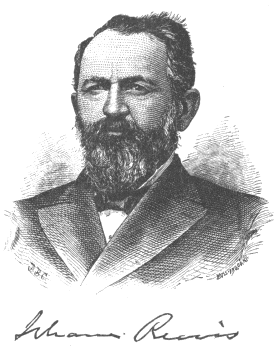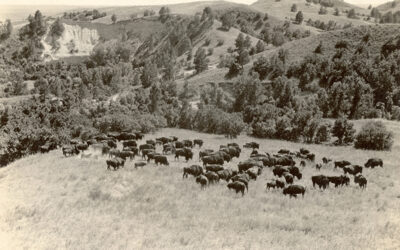
From Alfred T. Andreas, History of the State of Nebraska (1882).
Isham Reavis (1836-1914), pioneer lawyer, judge, and longtime resident of Falls City, began writing his autobiography in 1909. It was never completed, but the existing portion includes Reavis’s recollections of a Fourth of July celebration in Falls City in the late 1850s which seemed to have included everything but fireworks.
Reavis said, “Early in June we concluded to hold a Fourth of July celebration, . . . There was no shade of any kind in town, no grove, nor tree, nor any object that would cast a shadow of sufficient extent to cover twenty people. So we made one on the court house square, by setting posts in the ground with poles across, upon which we put boughs of trees cut in the Nemaha timber and hauled up for this purpose. In that way we made an arbor shady and snug, under which a company of three or four hundred strong could sit and escape the glare of a fierce July sun blazing above them.
“A beef, as they called a slaughtered specimen of the bovine tribe, was provided to be roasted for the refreshment of the people, and other provisions were made for the entertainment and comfort of the crowd that was expected to attend, but where it was to come from was a mystery to me. It turned out however, that there were more people in the country than I thought for. They came from all over the county and we had a crowd of several hundred people. A band of Indians in full native costume were secured to perform their traditional war-dance, under the auspices of their chief headsman, Po-to-ko-mah. He was a fine specimen of physical manhood.
“Another and quite an unexpected one in that brand new community, was a kind of mixed band of music under the leadership of Jim Dye, consisting of five or six persons and as many horns and fiddles, who played all the staple patriotic tunes, and then some, and furnished music for the dance that night at Jesse Crook’s new hotel building on the Richardson County Bank corner, lots 23-24, of block No. 70, then enclosed and nearing completion. They enlivened the scene greatly . . . .
“It is sufficient for the matter at hand, that we executed the common intention and celebrated in the usual way. Someone read the Declaration of Independence, and I made them a sophomoric speech, in which I have little doubt, a great deal of spread-eagle nonsense abounded, but it was a boy’s effort, delivered in perfect recognition of the solemn occasion and, whether well or ill performed, did its office, and that was enough.”



